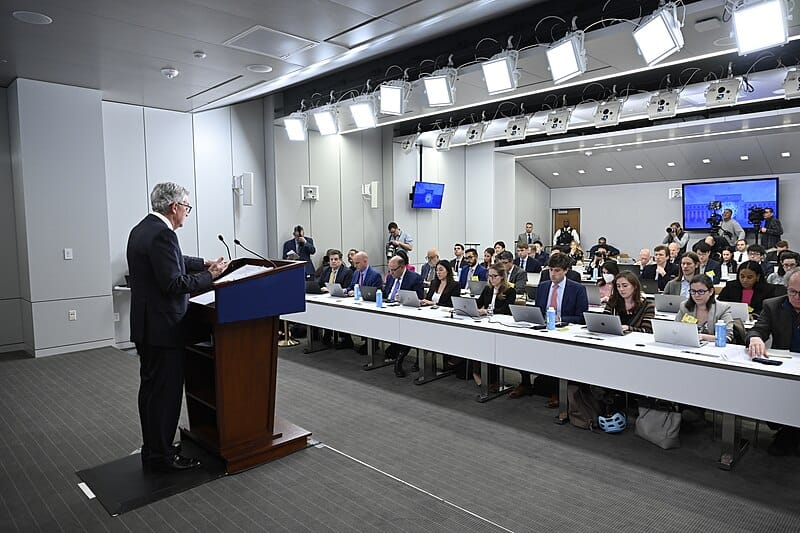"Your Banker's Calling" Reflections On The Nation's Debt

For anyone who's ever had a bank loan, from a credit card to a home mortgage, you know the chill that runs up your spine at the mention of a phone call from your favorite bank lender. The thought that you've missed a payment, or even if you're late, brings in all the ramifications of a loss in credit score, or, even worse, a hefty penalty or, worst of all, a foreclosure.
At that moment, you realize that the banker isn't a member of the family or a friend but an often unforgiving force [of nature] that must be dealt with.
To whom are we indebted?
Not a day goes by that the financial press doesn't remind us that our country is heavily in debt—$37 Trillion! $37 Trillion! They shout as if to say we're all headed to "rack and ruin."
But just who owns our debt? And would there be any flexibility in its repayment?
Many of those same Cassandras who remind us of the amount of our debt quickly add that China holds much of that debt and can ruin us at any time by simply withdrawing their loan. In the latest report, China indeed holds a substantial amount of debt, in the form of US Treasuries, $760.8 Billion. You can find that report here:
https://ticdata.treasury.gov/resource-center/data-chart-center/tic/Documents/slt_table5.html
But while the Chinese are a major holder of Treasuries, they're far behind the number one, Japan. The Japanese hold nearly twice as much, at $1,079.3 Billion.
Put another way, China owns roughly 2% of US Debt, while Japan owns nearly 3%. Although these two countries have been rivals throughout history and rarely, if ever, act together, even if both countries decided to withdraw their investments, it would mean a haircut of only about 5% of US Debt—something we could manage.
However, there is a much greater force lurking in the background, one that does have tremendous influence over our financial future. It's the nation's banker, the Federal Reserve.
It's a fascinating story about how the Federal Reserve obtained all those US Treasuries it now holds in its books. Today, we only have time for a thumbnail sketch.
When the COVID-19 pandemic began, the Fed owned roughly $4 trillion in Treasuries. You no doubt recall those times when stimulus checks were deposited in your bank accounts, public institutions were given aid, and corporations and banks provided financial support. The process was Quantitative Easing, and when the dust settled, the Fed had acquired an additional $5 trillion in Treasuries.
That capital injection took two years, from March 2020 until March 2022. Since then, the Fed has been selling those Treasuries, taking them off its books. In the three years since the Fed began selling, it has reduced its position by $2.25 Trillion, or more than one-quarter.
Here's where the confusion lies. Many, even several financial analysts, see this as a reduction in the nation's overall debt. IT IS NOT.
The massive sales of treasuries by the Fed results in a reduction in the Fed's debt, not the nation's debt. In fact, by reducing overall liquidity in the financial system, the Fed encumbers the rest of the country with more debt, not less. Put differently, the funds used to "buy back" the Fed's Bonds come, to a very large extent, from other bonds issued by the US Treasury. Essentially, taking debt from the Fed's books and placing it on the US Treasury's.
Most of us should ignore the periodic performance of the Federal Open Market Committee's (FOMC) interest rate decisions and instead focus on the Thursday H.4.1 Release of the latest Assets and Liabilities of the Federal Reserve.
https://fred.stlouisfed.org/release?rid=20
This is where the real news is. For the past three years, it has been a tale of the Fed removing liquidity from the nation's financial system as it retires its massive Treasury position.
All of this will have a tremendous impact on the economy. If, as many of us believe, the economy is not as strong or buoyant as the Fed believes, then any reduction in liquidity will depress commercial activity. The last three-quarters of GDP Growth has shown declines. There is a decline in business and consumer confidence and a recent uptick in unemployment. Retail sales are a basket case, with real disposable personal income showing mere fractional growth for years.
Many factors have contributed to this muted outlook, such as pending tariffs, reduced fiscal dominance, and regulation changes. Nonetheless, the Fed's reduction in system liquidity has been the overarching factor. Watch that Thursday Fed Report (H.4.1) to see how much the Fed continues to put on the brakes on the economy.
The Fed's ongoing program of removing liquidity from the system—to date, $2.25 Trillion—is paving the way for a tight money crisis. In the coming weeks, this is likely to become a chief economic trajectory.
EPILOG
Bank loans can sometimes be adjusted, and interest rates, loan schedules, fees, and other terms can be changed. As a real estate developer, Donald Trump, on occasion, used these adjustments to save some of his commercial projects. Unfortunately, US Treasuries do not have such provisions.
But imagine if 20% of the nation's debt could be converted to some novel loan from the Federal Reserve. Then, such an accommodation might be reached, helping put the country back on a solid financial footing.
Regrettably, such a vision remains a mere fantasy, as no bank, even the Federal Reserve, has sufficient capital to make such a loan. But given the President's background, it would not surprise me to see him attempt to renegotiate the current terms and conditions of our National Debt.
**
If you enjoyed this article, please consider buying me a cup of coffee.
Go to:
https://buymeacoffee.com/davidreavill
Thanks for reading!